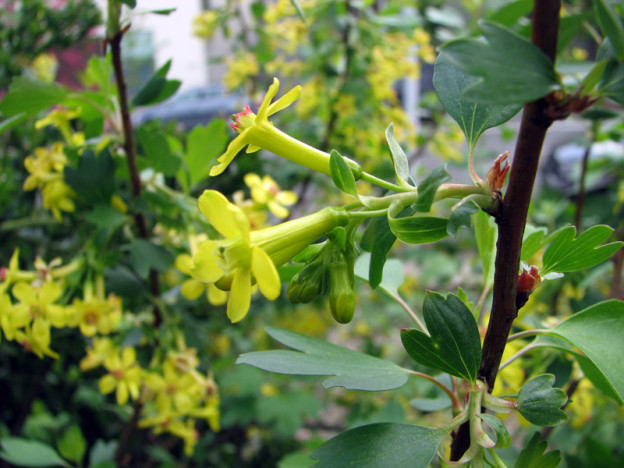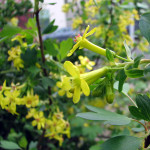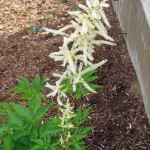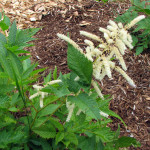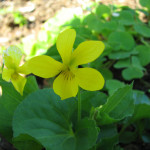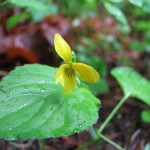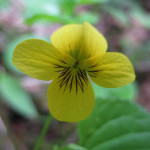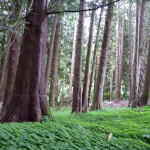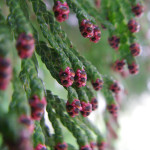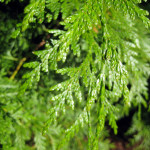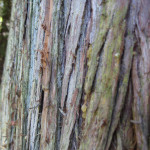Ribes aureum
Golden currant (Ribes aureum) is a small to medium-sized deciduous shrub named for its golden flowers and golden red fall foliage. It is common in Oregon and Washington east of the Cascades and into the Great Basin.
Golden currant grows in full sun and partial shade, in dry to moist conditions, and is drought tolerant. The leaves are deciduous, lobed, and vaguely maple-like, ½ – 1½ inches. Charming clusters of yellow flowers bloom from mid- to late-spring. Golden currant grows to approximately 6 feet tall by 6 feet wide.
It attracts hummingbirds and butterflies such as the spring azure and mourning cloak, and the fruit is eaten by birds and other wildlife. Combine this in a sunny spot with its cousin, red-flowering currant, and drought-tolerant groundcovers like alliums and camas, for a beautiful native display!
- Light Requirements: Full Sun, Part Shade
- Water Requirements: Dry, Moist
- Ease of Growing:
- Growth Rate: Moderate
- Spreads: No
- Wildlife Support: Hummingbirds, Birds or Mammals
- Fire-resistant: No
- Edible: Yes
- Mature Height: 6ft
- Mature Width:6ft
Goat’s Beard

Aruncus dioicus
Goat’s Beard has decorative finely-cut foliage and will create a bold, showy effect for a moist or partly-shaded spot all season. Dense, feathery plumes of tight white flowers rise well above the foliage spring to summer.
Goat’s Beard is an excellent background plant or grouped in a woodland setting. It dies back to the ground in winter, only to return gloriously in the spring. Goat’s Beard spreads slowly by rhizomes to form attractive patches, and can be planted in more sunny areas provided there is good moisture. It’s a “host” plant to the Dusky Azure Butterfly.
- Light Requirements: Part Shade, Full Shade
- Water Requirements: Moist, Perennially Wet
- Ease of Growing: Easy to grow
- Growth Rate: Fast
- Spreads: Yes
- Wildlife Support: Pest-eating Insects, Birds or Mammals, Pollinators
- Fire-resistant: No
- Edible: No
- Mature Height: 5-15ft
- Mature Width:3-5ft
Lady Fern
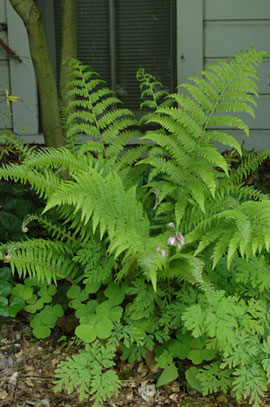
Athyrium filix-femina
Athyrium filix-femina (Lady Fern or Common Lady-fern) is a large, feathery species of fern native throughout most of the temperate Northern Hemisphere, where it is often abundant (one of the more common ferns) in damp, shady woodland environments and is often grown for decoration in shady home gardens.
- Light Requirements: Full Sun, Part Shade, Full Shade
- Water Requirements: Moist, Seasonally Wet
- Ease of Growing: Easy to grow
- Growth Rate: Moderate
- Spreads: No
- Wildlife Support: Hummingbirds, Birds or Mammals
- Fire-resistant: No
- Edible: No
- Mature Height: 4ft
- Mature Width:2ft
Wood Strawberry

Fragaria vesca ssp. bracteata
After flowering, rounded, egg-shaped, red edible berries appear in the late summer and early autumn. These appear to be smooth coated but are in fact covered in very short hairs, visible only at close range.
- Light Requirements: Full Sun, Part Shade
- Water Requirements: Dry, Moist
- Ease of Growing: Easy to grow
- Growth Rate: Moderate
- Spreads: Yes
- Wildlife Support: Birds or Mammals
- Fire-resistant: Yes
- Edible: Yes
- Mature Height: 6in
- Mature Width:1ft
Yellow Wood Violet
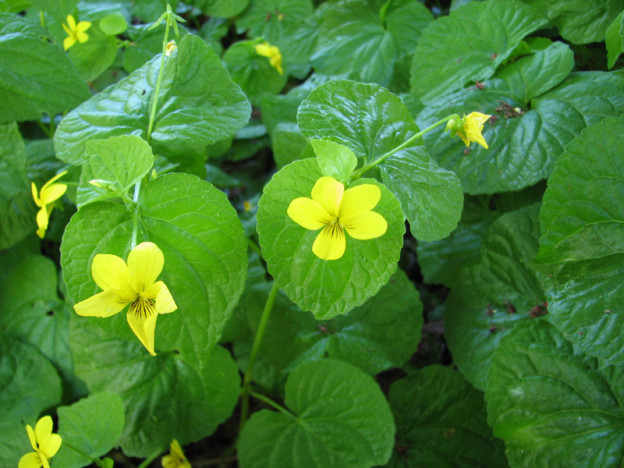
Viola glabella
Yellow wood violets have large, bright-green, heart-shaped basal leaves just below deep-yellow, pansy-like flowers. The lateral and lower petals are marked with purple veins. Slender leaning or erect stems with leaves only in upper one-third, and bilaterally symmetrical, yellow flowers facing outward, hanging from slender stalks.
A very common species in moist, shaded places in woods. Most western Violets have yellow rather than purple corollas, but all have the perky little flower with a spur or pouch behind the lower petal. The lower petal forms a landing platform for insects seeking nectar within the spur.
- Light Requirements: Part Shade, Full Shade
- Water Requirements: Moist, Seasonally Wet
- Ease of Growing: Easy to grow
- Growth Rate: Fast
- Spreads: Yes
- Wildlife Support: Pest-eating Insects, Birds or Mammals
- Fire-resistant: No
- Edible: Yes
- Mature Height: 4-9in
- Mature Width:6-12in
Western Redcedar
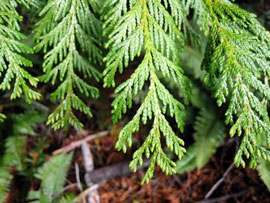
Thuja plicata
Western redcedar (Thuja plicata) is a large evergreen conifer treasured not only for its beauty, but also its wildlife value and cultural significance going back to time immemorial.
Mature Western redcedars can get 115 – 230 feet tall. The flat, elegant sprays of foliage makes the tree look like it is draped with lace, especially when dusted with frost or snow. The cones are slender with overlapping scales. This tree is actually part of the cypress family, and not a true cedar (just like Douglas-fir is not a true fir).
Western redcedars make excellent wildlife habitat, providing food and shelter for many species. Rosners hairstreak butterflies are only found in association with this tree, as they depend on it for reproduction and food for their young. Large and small mammals feed on the leaves and inner bark for most of the year; squirrels and other rodents use its shredded bark for winter nests; and many birds and small mammals find shelter and nest sites in red cedar cavities.
Western redcedar is a iconic tree of the Pacific Northwest. If you have a shady, moist spot large enough for it to thrive, this is a beautiful and valuable addition to any forested landscape.
- Light Requirements: Full Sun, Part Shade, Full Shade
- Water Requirements: Moist, Seasonally Wet
- Ease of Growing: Easy to grow
- Growth Rate: Moderate
- Spreads: No
- Wildlife Support: Birds or Mammals
- Fire-resistant: No
- Edible: No
- Mature Height: 100-200ft
- Mature Width:30ft
Oregon White Oak
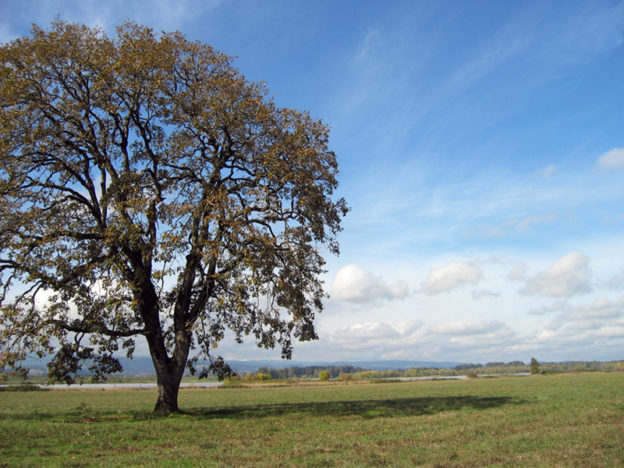
Quercus garryana
The iconic Quercus garryana, also known as Garry oak and Oregon white oak, is a drought tolerant tree that can also tolerate prolonged seasonal flooding. It can often grow on sites that are too dry for other tree species. These slow-growing trees are smaller at maturity than many Pacific Northwest trees, growing eventually to a maximum size of 65-80 ft tall and wide. They have deep tap roots and widely spreading roots, making them resistant to wind-throw. Mature trees growing in open areas develop broad oval crowns, making them excellent shade trees.
The leaves are deciduous, 3-6″ long and 2-5″ broad, with 7-9 deep lobes on each side. The flowers are catkins, and the fruits are small acorns about 1″ long with shallow, scaly cups.
Over 200 species of wildlife benefit from Oregon white oaks, including pollinators such as Fender’s blue, Taylor’s checkerspot, Mardon skipper, Islad marble, and the Oregon silverspot. The Oregon white oak is also the only known food for the caterpillars of Propertius duskywing butterflies and a leaf-mining moth. Deer, bear, raccoons, squirrels, and many small mammals eat the acorns, as do wild turkeys, band-tailed pigeons, woodpeckers, jays, and others.
Oregon white oaks also have significant cultural value for many Native tribes. For all these reasons, Oregon white oaks and their associated prairie habitats are the focus of many regional conservation efforts.
- Oregon white oak (Quercus garryana) has thick, fire-resistant bark. Younger trees are more vulnerable.
- Light Requirements: Full Sun
- Water Requirements: Dry, Moist
- Ease of Growing: Moderate
- Growth Rate: Slow
- Spreads: No
- Wildlife Support: Pest-eating Insects, Birds or Mammals
- Fire-resistant: Yes
- Edible: No
- Mature Height: 25-70ft
- Mature Width:30-60ft
Blue Elderberry

Sambucus cerulea
Blue elderberry (Sambucus cerulea) is a large, fast-growing deciduous shrub or small tree featuring showy clusters of creamy-white flowers that mature into large clusters of blue-black berries.
This shrub is a great addition to your wildlife garden. Many birds eat the berries, and butterflies visit the flowers for nectar. The plant provides food for the young of spring azure butterflies and various moths. Native solitary bees shelter and lay their eggs in the hollow twigs. Dead elder wood is also the preferred habitat of the mushroom Auricularia auricula-judae, also known as Judas’ ear fungus or wood ear fungus.
Blue elderberry can get quite tall, reaching up to 15 feet in height. Plant it in sun to part shade in well drained soils.
- Light Requirements: Full Sun, Part Shade
- Water Requirements: Dry, Moist
- Ease of Growing: Easy to grow
- Growth Rate: Fast
- Spreads: No
- Wildlife Support: Pollinators, Pest-eating Insects, Birds or Mammals
- Fire-resistant: Yes
- Edible: Yes, but parts of the plant toxic
- Mature Height: 10-25ft
- Mature Width:18ft

